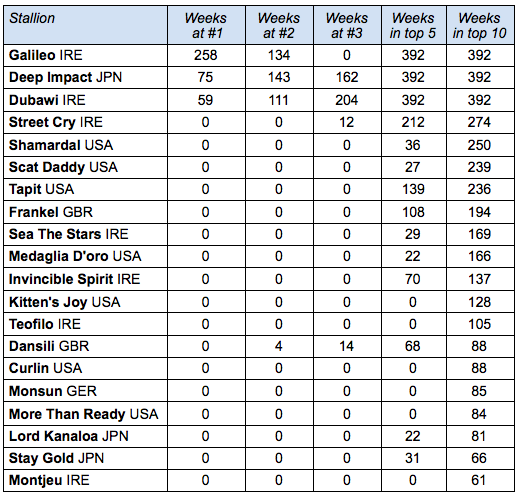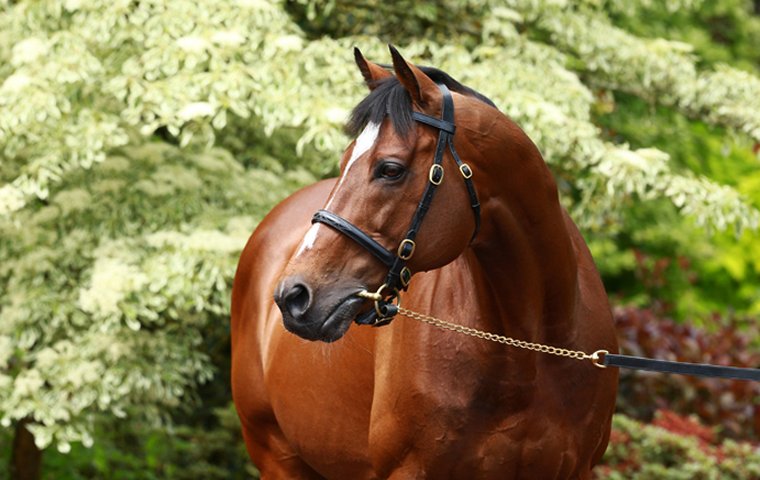
When Sadler’s Wells died in 2011, there was an assumption that we would never see his like again. We were wrong.
As news of Galileo’s death at Coolmore filtered out on Saturday, the racing world was united in its mourning for a horse who had changed the face of the industry over a relatively short period of time.
Every so often, a stallion rises above others to alter the course of the breed. The impact of Northern Dancer, grandsire of Galileo, changed the Thoroughbred forever. In Japan, Sunday Silence and the ambition of the Yoshida family alone propelled that industry to unseen heights.
Europe’s ‘Northern Dancer’ was the Coolmore behemoth Sadler’s Wells, whose immense success at stud consisted of 73 G1 winners and was a key component to the rise of the operation and its racing arm, Ballydoyle, as a result. His run of 14 British and Irish sires’ championships had surpassed the record set by Highflyer in 1798; to think back in 2011 that another record-breaker was around the corner would have been a far-fetched notion.
Yet in Galileo, here is a stallion in possession of a record 92 G1 winners - the latest achieved on Saturday when Bolshoi Ballet posted a poignant success in the Belmont Derby - and 338 stakes winners overall. Nor can any other stallion boast five Epsom Derby winners.
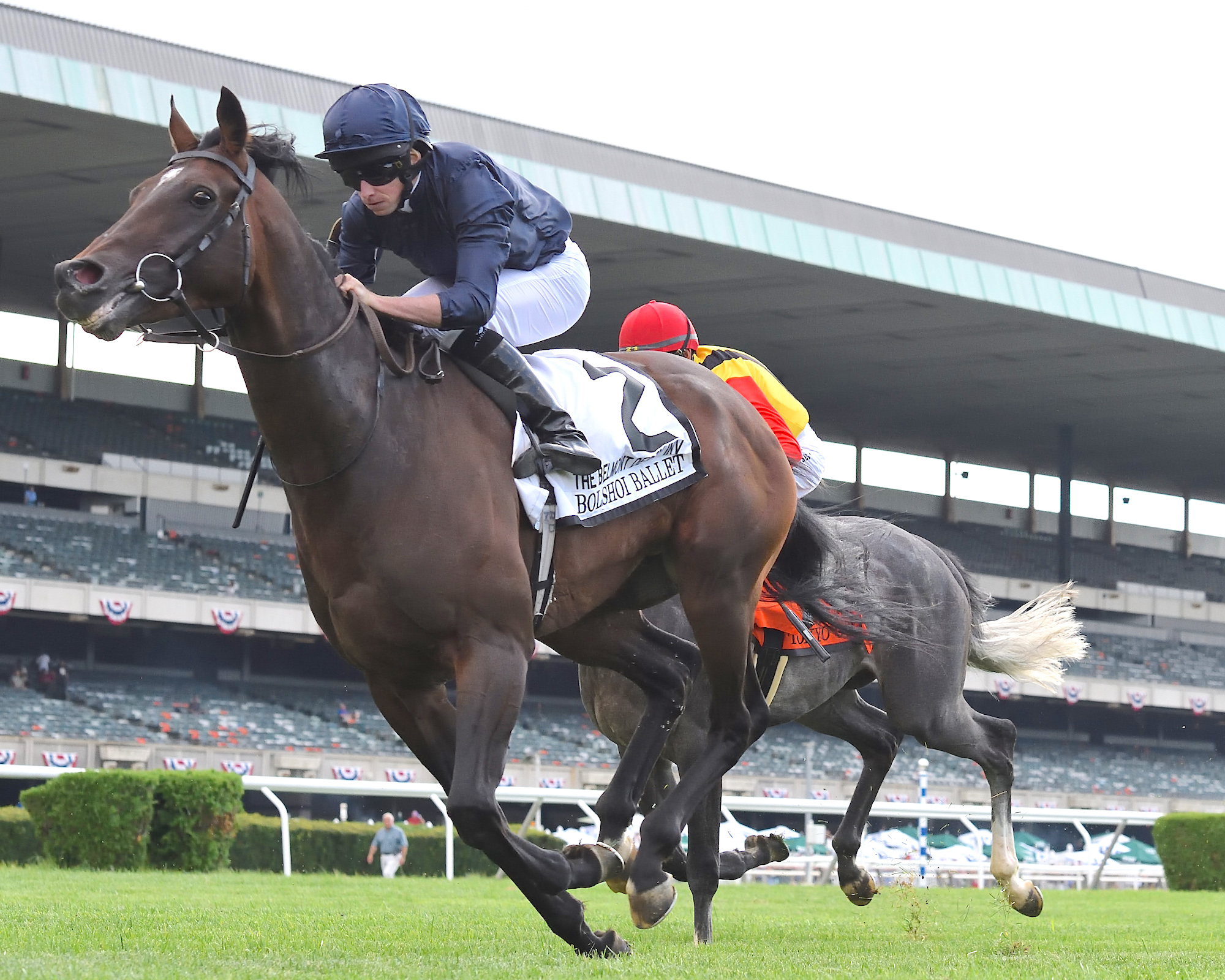
Such is his dominance over the breed that he already possesses over 20 G1-producing sons at stud and also appears as the damsire of 34 top-flight winners. Perhaps, as with Northern Dancer, the time will come when a pedigree without his presence is viewed as an anomaly; after all, recent months have featured an Irish Classic winner, Mac Swiney, with two doses of Galileo in his background.
And then of course there are the 12 British and Irish sires’ championships, only two short of Sadler’s Wells. With three crops to come alongside a group of 112 juveniles yet to be fully tested, it doesn’t take too much imagination to envisage Galileo matching and even surpassing the record set by his sire.
At the time of Sadler’s Wells’ retirement from stud duty in May 2008, Galileo was just coming to the end of his first season at a private fee. The search for an effective heir had been ongoing for some time. In The Wings, Barathea and El Prado were established as important sons, but they were under the management of Darley, Rathbarry Stud and Adena Springs in Kentucky.
By contrast, the Coolmore roster had been hit by disasters, such as Entrepreneur and King Of Kings. Even so, the regularity of the Sadler’s Wells production line suggested that it was only going to be a matter of time before that was remedied and by the time Sadler’s Wells covered his last mare. His Fethard legacy appeared in safe keeping through Montjeu, Galileo and High Chaparral.
Expectation
For Galileo, a weight of anticipation had accompanied him throughout his early years as a son of David Tsui’s Arc heroine Urban Sea. Horses being what they are, such expectation is invariably misplaced. But by all accounts, Galileo was impressive from the beginning at Ballydoyle.
He was spoken of as a legitimate Derby candidate before he had ever stepped on to a racecourse and, when he slammed the opposition by 14 lengths in a back-end Leopardstown maiden on his only start at two, he naturally headed into the winter as a strong choice to provide Aidan O’Brien with his first Derby winner.
O’Brien was effusive in his praise for the horse following his Leopardstown romp, telling the Racing Post, “He's definitely top-class and is an exciting prospect for next year. We had big plans for him this season, but he coughed for most of the year.”
Galileo consolidated those hopes the following spring with a pair of bloodless victories in the Ballysax Stakes and Derrinstown Stud Derby Trial. Ballydoyle also housed Milan (who would go on to win the St Leger) but it was clear from an early stage that Galileo was regarded as the yard’s only serious Derby colt and he duly lined up at Epsom as the 11/4 joint favourite alongside the 2000 Guineas winner Golan.
At that stage, Sadler’s Wells had yet to sire a Derby winner. The horse had not failed through lack of opportunity, but it has to be remembered that plenty of his progeny were heavy shouldered, high-actioned individuals effective in softer conditions; Galileo, with his low, panther-like stride and rapid turn of pace, was a different kind of animal and, having adapted well to Epsom’s undulations, he quickened clear to win easily under Mick Kinane.
Galileo’s win that day evoked comparisons with Generous and Nashwan and he continued to sweep all before him that summer with a wide-margin win in the Irish Derby and battling success over Fantastic Light in the King George.
Surprisingly, given his dominance within the 3-year-old division, the King George turned out to be his final win. Fantastic Light subsequently had his measure in the Irish Champion Stakes, although he was pressed all the way to the line by Galileo, who had been forced to challenge wide round a tiring Give The Slip. A fruitless try on dirt in the Breeders’ Cup Classic at Belmont Park brought a low-key curtain down on an otherwise outstanding career.
Rapid rise
Galileo’s brilliance and strong female family negated some of the suspicion that the market may have held at that time towards middle-distance sons of Sadler’s Wells. He was installed at Coolmore for the 2002 season at a fee of Ir£50,000 and was deservedly well supported, his first crop consisting of 126 foals.
It is remarkable to think that there was only one stakes-winning 2-year-old - Khalid Abdullah’s Washington Singer Stakes scorer Innocent Air - in that first crop. A debate between several breeders at Tattersalls in the winter of 2005 as to whether Fantastic Light or Galileo would develop into the better sire remains fresh in my memory; a year later and there was no contest.
That first crop would come to include 13 stakes winners. Margeurite Weld’s homebred Nightime opened the Classic floodgates by capturing the 2006 Irish 1000 Guineas while Sixties Icon led home a 1-2-3 for the sire in the St Leger, run that year at York. Back in third that day was Red Rocks, who signed off that year by taking the Breeders’ Cup Turf.
Galileo’s very first winner, Heliostatic, also won a G3.
It was very fitting that Heliostatic was bred, owned and trained by Jim Bolger given the overall influence the master Coolcullen handler has come to exert over Galileo’s career.
Bolger took advantage of Galileo to great effect, even as his fee slipped to a low of €37,500, and was rewarded as the breeder of Teofilo, the unbeaten champion 2-year-old of 2006 who was the standout of seven stakes winners from his sire’s second crop, Soldier Of Fortune, the runaway Irish Derby winner of 2007, and Cuis Ghaire, whose win in the 2008 Albany Stakes at Royal Ascot proved in no uncertain manner that Galileo could throw a fast 2-year-old.
Bolger also trained Galileo’s first Derby winner, New Approach, whose Classic campaign in 2008 followed off the back of a championship 2-year-old season.
And therein lies the key. While Sadler’s Wells was capable of throwing top-class 2-year-olds, they were quite often the back-end type of horse campaigned with the future very much in mind. On the other hand, barely does a year go by now when Galileo is not represented by a top 2-year-old; think Frankel, Churchill and his sister Clemmie, Gleneagles and his sister Happily, Love, Misty For Me, Minding, Rhododendron and the iron mare Found, all of whom trained on into excellent older performers having won at G1 level at two.
He threw them all
Any age, any ground, any distance, any sex - Galileo threw them all.
There has been at least two G1 winners in every crop to date (aged 3 and above), and no fewer than eight emerged out of those produced 2008 and 2013.
An annus mirabilis in 2017 was illustrated an incredible British and Irish prize-money total of close to £12 million. It was a year that not only encapsulated the dominance of Galileo but also his versatility, consisting of the dual Guineas winners Churchill and Winter, St Leger hero Capri, globetrotter Highland Reel, Eclipse Stakes and Juddmonte International winner Ulysses, juvenile G1 scorer Clemmie, Irish Champion Stakes hero Decorated Knight, outstanding stayer Order Of St George and the top-class 3-year-old fillies Rhododendron and Hydrangea.
With Galileo increasingly becoming the private domain of Coolmore and its associates as the years went on, Ballydoyle has naturally housed the majority of his G1 winners. No one knows his progeny better than Aidan O’Brien, who often speaks admiringly of their constitution and mental strength. In turn, no stallion and its progeny has clicked with the trainer quite so well, and therefore influenced the recent history of Ballydoyle.
Once it was clear that Galileo worked with faster mares more effectively than his sire, that opened up a whole array of options for breeders. Successfully crossing fast mares such as Meow (dam of Churchill and Clemmie), You’resothrilling (dam of Gleneagles, Marvellous, Happily and Joan Of Arc), Margot Did (dam of Magic Attitude) and Laddies Poker Two (dam of Winter) were among the cases in point for Coolmore.
And of course for Juddmonte, the decision to send their listed-winning sprinter Kind reaped the ultimate reward in Frankel.
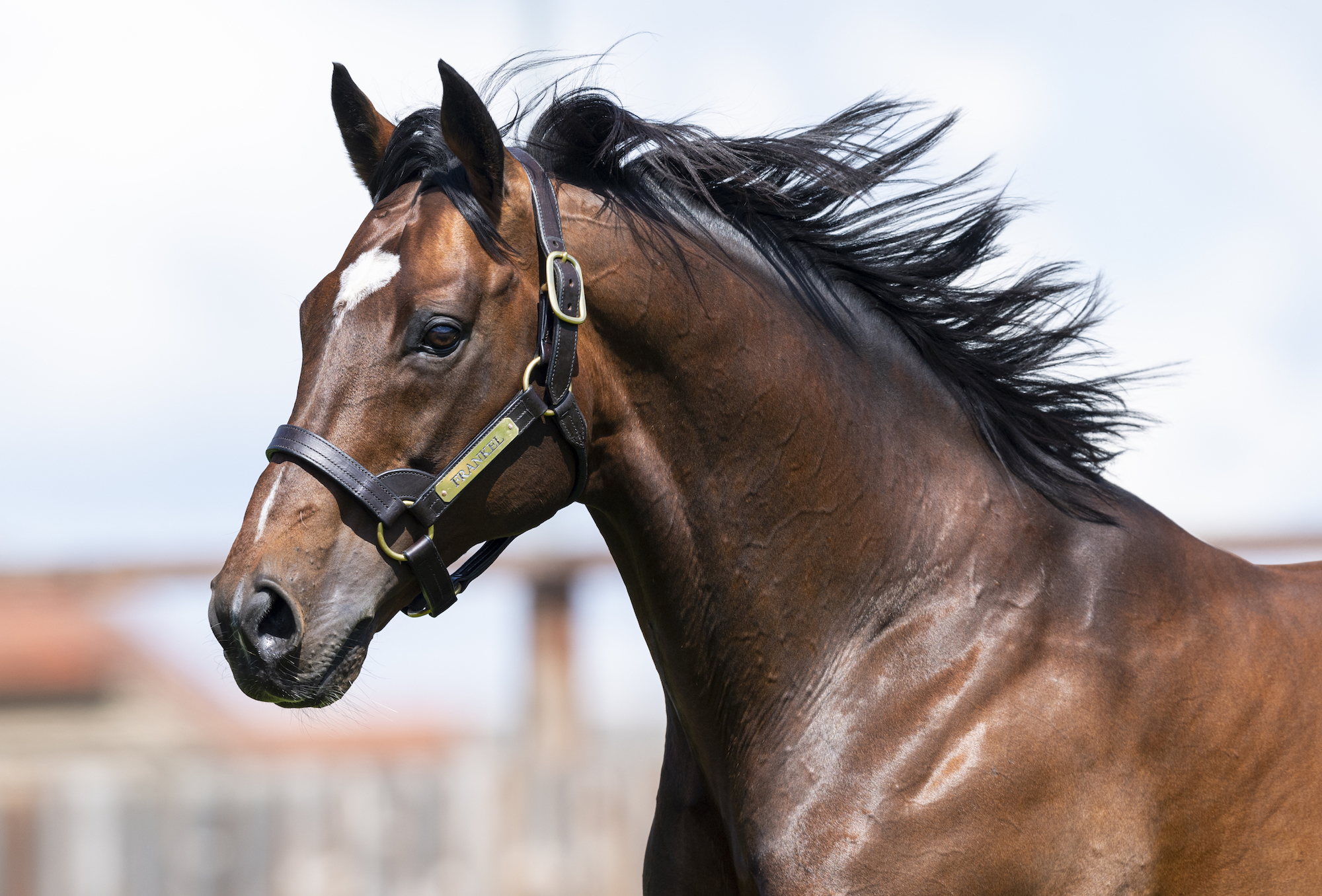
Juddmonte’s flamboyant homebred is deservedly regarded as the best racehorse of the recent era. His unbeaten 14-race winning sequence was the longest seen in Europe since Ribot, foaled in 1952, and took in ten G1 victories, among them an unbelievable display of front-running power in the 2000 Guineas, an 11-length win in the Queen Anne Stakes and a similarly dominant score in the Juddmonte International.
He retired with a Timeform rating 147, the highest figure awarded in the organization’s history, and is now regarded as one of Europe’s premier stallions; indeed, if any horse is to break Galileo’s reign as champion British and Irish sire, it could well be Frankel - and perhaps as soon as this year given his haul includes the Derby winners Adayar and Hurricane Lane alongside last week’s Falmouth Stakes heroine Snow Lantern.
Nowhere, however, will the hunt for a successor be more crucial than at Coolmore. The operation currently stands eight of his sons under its flat banner worldwide and another six under its jumps arm.
Australia is the most accomplished of the flat group as the sire of four G1 winners. Like Galileo, he tends to throw sound, genuine stock who are well liked by trainers. And, should he start receiving some of the faster mares that would have normally been slated for his sire, then his future could be particularly interesting. Gleneagles is having a fine year thanks to six stakes winners, although a G1 winner still eludes him, while Churchill has fired in eight first-crop winners so far this year.
Another four on the Coolmore roster, namely Magna Grecia, Saxon Warrior, Sottsass and U S Navy Flag, are also out of Galileo mares. It’s a fine snapshot of Galileo’s brilliance yet such overwhelming presence could ultimately present a conundrum for Coolmore, a concern that no doubt influenced last year’s acquisition of Wootton Bassett.
Outside of Coolmore, the mantle will obviously be assumed to some degree by Frankel, while Newsells Park Stud’s Nathaniel has ensured his place in history as the sire of Enable. Teofilo and New Approach have also been excellent stalwarts for Darley, siring 30 G1 winners between them; Teofilo enjoyed a particularly fruitful 2020 as the sire of six G1 winners, while New Approach remains in the news this year as the sire of Mac Swiney and grandsire of top miler Poetic Flare, by Dawn Approach.
Frankel’s brother Noble Mission even sired a G1 winner on the dirt in Code Of Honor.
If there was an underwhelming aspect to Galileo’s body of work, however, it has been the inability of his line to take root in the U.S. Of course, there remains time for a son or grandson to make an impact, but enthusiasm has to be tempered by the failures of Cape Blanco and Magician as well as the recent export of Lane’s End Farm’s Noble Mission to Japan.
Similarly, Galileo’s record in Australia, to where he shuttled during his early seasons, and Japan falls short of that achieved in the Northern Hemisphere. Having said that, Adelaide, Rip Van Winkle and Teofilo have each tasted G1 success from their seasons in Australasia, while Frankel continues to enjoy immense success with his runners both there and in Japan.
Galileo didn’t have to fight for opportunity, but he made the most of those afforded to him at every point of life. Naturally, he succeeded by imparting talent, in later years to complement the array of outstanding mares sent to him. However, there is also a willingness and durability to his stock that consistently sets them apart, and it is those attributes that are now standing a number of his sons in good stead at stud.
There remains time for Galileo to overhaul Sadler’s Wells’ record of sires’ championships and to also hit the landmark of 100 G1 winners. Perhaps there will even be another Epsom Derby winner or two. Undoubtedly, his reputation as an outstanding broodmare sire will continue to grow. But for now let’s celebrate Galileo for his record as it stands and remember him as a phenomenon who did so much for the sport on a global scale.
Galileo in the TRC era
Data from TRC Global Rankings
SIRES WITH THE MOST GROUP/GRADED WINS SINCE 2011
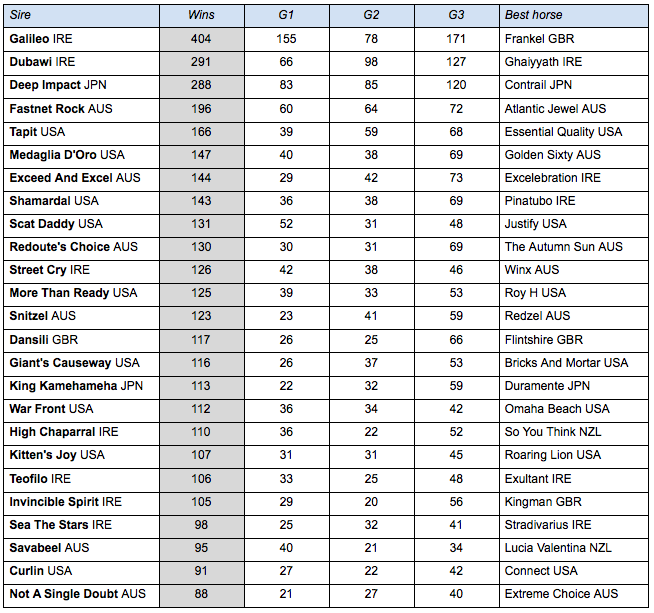
GALILEO’S BEST HORSES SINCE 2011
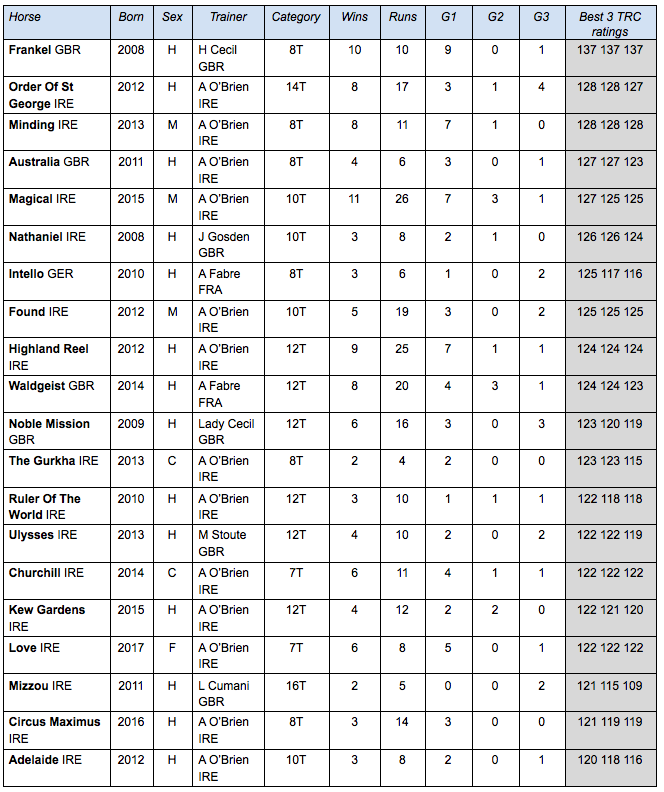
HOW MANY WEEKS THE TOP SIRES HAVE BEEN PROMINENT IN THE RANKINGS
